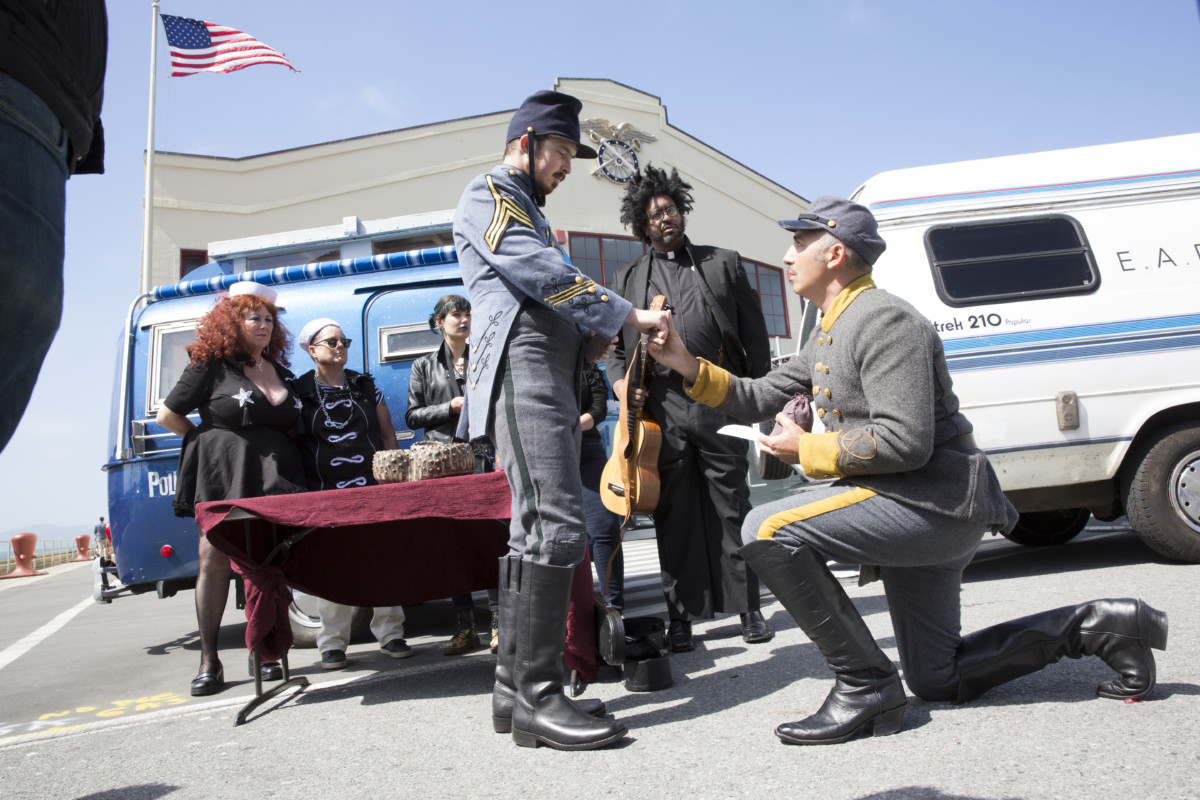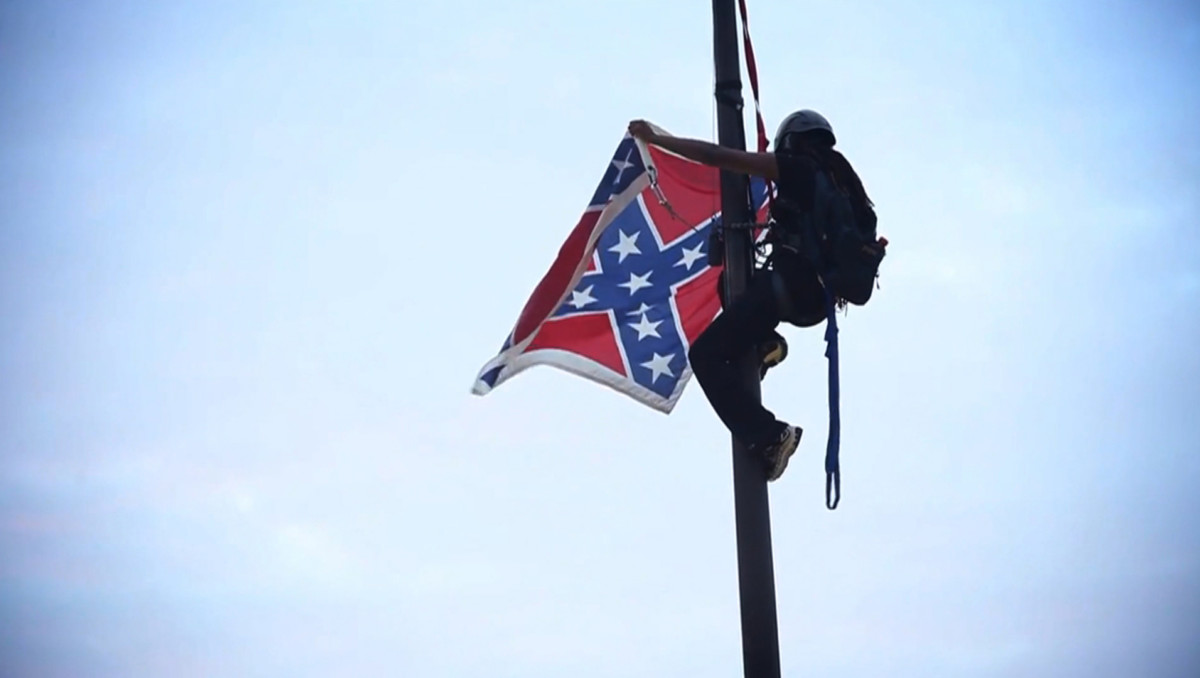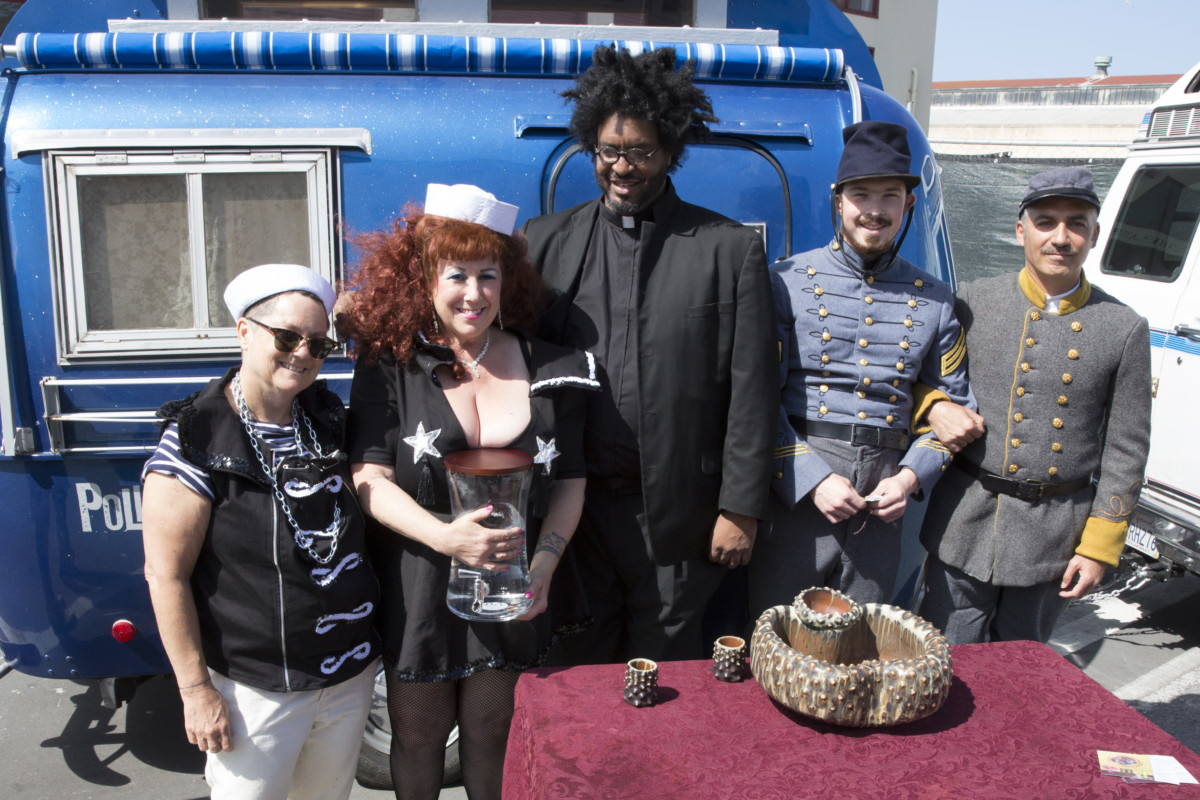
A Union soldier and a Confederate soldier walk into a gay bar in the Castro and the bartender says, “I’m sorry sirs, we don’t serve stars and bars in here.”
Sounds like an epic Comedy Sports groaner, but this is where we join Math Artist John Sims in his quest to eviscerate the corrupted corpse of the zombie known as the Confederate flag in the final chapter of his long term project: Recoloration Proclamation. A fifteen-year multi-media project, Recoloration Proclamation features: an exhibition of recolored and hanging Confederate flags, multi-state flag funerals, a play, a documentary film and a CD with thirteen black music versions of the song “Dixie.” And now, the project concludes in the San Francisco Bay Area with a staged wedding between a union and a confederate soldier.

It’s not unusual for two male soldiers to wed in the 21st century, but the time portal/wormhole that John Sims has created with his Re-Union Wedding transposes this scenario to a near future probability with intriguing outcomes.
Sims wrote the vows that the soldiers exchanged at Fort Mason:
Confederate Soldier
My dear Brother,
I am blessed to stand here before you
and before God
To Declare my Love and Comfort
in the Vision of an infinite Togetherness
While our battles have been long and weary
Our humanity tried and tested
I find salvation and redemption in our march forward
For we have no choice but to choose the road to unity and union,
for we have no choice but to bury our dead and our past
And move forward in peace.
Union Soldier
I am you as you are Me
Our virtues and Pathos
are born from the same womb.
It was not the intention to cause such grave disruption and
despair,
but to save ourselves at all cost
and while collateral concessions may have remedied
constitutional contradictions
we never wanted to vanish completely the natural endowment of
our place in the order of things
A marriage between warring factions, pivoting around the idea of supremacy makes one wonder if at some point these intense vows, which reveal longings for reunification, burned in the hearts of young men who could see that the battle was just the pretext for some epic make-up sex.
Said conjugal activity subsequently has been sadistic and rendered across proxy bodies. This is an understatement.

John Sims once told me that he wanted to be a Section A artist, not one you have look for in the Arts & Culture section.
So of course the wedding party would be feted with a Water Toast by a feminist artist and a sex goddess badass, Beth Stephens and Annie Sprinkle, at an old Union fort, then traipsed down the avenues to San Francisco City Hall where vows would be exchanged, and a jig was had. Then the procession triumphantly proceeded to the Castro for a wedding march, finally culminating with a BART ride under the Bay to Oakland to frolic at the Black Poetry Slam-sponsored Juneetenth event for a listening party for Sims’ “Afro Dixie Remixes.” It happened this way, of course, because it’s illegal to fly the Confederate flag in California, anywhere.
That little bit of policy wonking aside, Sims’ choice to perform the wedding in California casts “mad side eye” on the Union Army’s project of nation building.
You can call this piece a time travel device, probably a wormhole. A spell, even. Or is it a tromp l’oeil executed not only over a visual horizon, but a time horizon as well?
The Red, White & Blue Box
In his previous art performances, John Sims has burned the rebel flag, issuing a call for “A Burn and Bury Memorial” every Memorial Day. While “historians” caution that the flag was just a tool used on the battlefield to regroup troops, and hence has no inherent contemporary value, Sims has buried the Confederate flag, adorned it in sequins, and “properly hung” it while KKK members threatened his life for slandering “The Southern Way of Life.” If it is both a “way” and a decommissioned “beacon,” then what Sims has shown us is that this flag forms battlefields wherever it is raised.
Yet this emblem lingers, devouring common sense and decency while awaiting decommission. It’s not the type of tool you can ignore; it labors in silence, feigning decorum while preventing the evolution of societal norms.
A rallying tool, the Confederate Flag, first of all, is illegal. The Confederacy, while not required to concede defeat, in point of fact, lost the war. Yet this emblem lingers, devouring common sense and decency while awaiting decommission. It’s not the type of tool you can ignore; it labors in silence, feigning decorum while preventing the evolution of societal norms. Sims’ insistence on degrading this hagiography of an illicit social affair is brutally mesmerizing.

Twisting the Knobs
I remember the first time I told a friend about John Sims’ “Confederate Flag Project.” We were in the middle of a hilarious, yet deep conversation about Black art makers, social politics, getting paid, finding/keeping an audience, you know, the usual, when we veered into long range projects. Often, it’s an accident. When an artist hunkers down with a project, the project either paid really well the first go round, or the artist can’t get the damn thing to let go.
So we were laughing about divorcing our subject matter, when I mention this cat I’d met on MySpace back in the day who reconnected with me on Facebook recently. Laughing hysterically about the quilt phase, I casually mention that John was on his way to South Carolina to burn the rebel flag now. Nine black people had just been murdered in a Bible Study session by a young white supremacist at a church where Denmark Vessey had planned a slave revolt during 1819. My startled friend went silent, then asked if John had back up. I suddenly realized that I may never see the Political Math Artist on Skype again.

Image credit: Democracy Now
In that silence, we knew that we had to do something for John Sims to make it out of South Carolina alive, but we had no idea what that something could possibly be from the Left Coast. In typical perpetual sunshine style, we resolved to send him “some protective ,” knowing full well that attempting to bring his art in conversation with our own out here in La-La Land would be met with confusion and consternation in art circles; though our people in South Central, Altadena, and the Inland Empire would know exactly what was up.
The truth is you don’t have to be “down South” or “back East” to experience the violence of the Confederate flag. Recently a Black Lives Matter activist in Pasadena, California was sentenced to ninety days in jail using an anti-lynching law against her. Such convoluted legal processes are birthed by a nation which continues to allow the presence of a flag that is a stand in for hate speech, even in states where its hold is alleged to be minimal. This is a point that Sims drives home by locating both the engagement party and wedding of a Union Soldier to a Confederate one in California.

It’s Bigger on the Inside
It could be argued that the Mexican Cession of 1848 fueled Southerners’ arguments for seceding from the Union, as it was not guaranteed that slavery would be allowed in the new territories west of The Republic of Texas. As further quantum collisions of historical moments and locations, June 19th (Juneteenth as it is known by African Americans), is the date that slaves in Texas received word that they were finally free in 1865, a year and a half after the Emancipation Proclamation had been declared in 1863.
No doubt, the flying of the Rebel Flag gave pause to any would-be freeman in Texas. Eventually, after the collapse of the Reconstruction era, this became true for all African Americans. From Reconstruction, we can track John Sims’ investigations of the resurgence of the Confederate Flag, especially the one that was flown by the Navy of the South Carolina Confederates, as if he were attempting an Inception-like thriller, but on a social scale. Bloodied by the jagged edges of illogical state laws and their spawn—permits, policy and NIMBY-ism—we whirr back towards 2015, where and when the South Carolina Congress had to come to terms with flying too many flags for oppositional causes.
In June 2015, simultaneous to a “sudden” revelation that #blacklivesmatter, #loveislove birthed protections for Gay and Lesbian couples seeking to wed in the US. “States’ Rights” (an echo of “the South will rise again”) droned on as the reason to refuse to implement the Marriage Equality Act in much the same way that the Civil Rights Act pushed the federal government to legislate the right to public access for African Americans in 1964.
Sims’ work reverberates alongside this simulacra of the performance of “rights.”
Each phase of the Re-Coloration Project asks local artists and activists to not only consider the role of the Confederate Flag in undergirding both macro and micro racial aggressions, but actively work to make it transparent, then eradicate it.
Invited by Annie Sprinkle and Beth Stephens to collaborate in THIS IS WHAT I WANT Festival curated by Tessa Wills at Fort Mason in San Francisco, Sims opted not to work in his usual fashion: anticipating community activists to take up the cause in a complex combination of reenactment, protest, jest, interrogation, love and joy. Instead, he listed a casting call for a film. Watching the event unfold in its various locations, aside from Sims’ very convincing Church of God and Christ Minister, acting did not seem to be topmost in the minds of the soldiers or Sprinkle & Stephens. The night before The Water Toast, mayhem was unleashed in Orlando. Details were still murky.
Flag stays still. Flag works like a magnet, a beacon, a megaphone, a bomb, a bullet – surrounded by “art,” standing in Fort Mason, reading lines from crumpled paper, creating a touching ritual for rebirth, it acted as a repellent.
The toast became a plea for love and understanding. It had the trappings of a coyote-sly feint, transposing one battle of equality and acknowledgement with another. Flag stays still. Flag works like a magnet, a beacon, a megaphone, a bomb, a bullet – surrounded by “art”, standing in Fort Mason, reading lines from crumpled paper, creating a touching ritual for rebirth, it acted as a repellent.

You could see passersby skirt the edges of the performance area in each step of the journey of The Wedding: ReUnion. Awkward and destabilized, audiences in California were unsettled by their “weight to carry” in the performance. Is the piece satire? Is it conceptual work? Is it ritual of a new church? Is it performance art? Is it an experiential advertisement for a new CD? It’s an instigation to reflect on the battle that divides you within?
Tag, you’re it.
When Are We?
Work this gnarly, this uncomfortable and this timely deserves and requires a publicist. Not for the sake of spin, but for discovering the audience and catching them unaware.

From left to right : Dre, CeCe Jordan, Prophet Wright, John Sims, Derrick Carr, and Von Bellows.
If you watch the Periscope capture of the events with Annie Sprinkle and then again with Sims himself at the wedding, you might notice the audience is small. I suspect this is a result of gun shyness, partially from the artist and also his presenting host. They didn’t do much promotion for the event, perhaps due to the reception of his previous work at Gettysburg, where Sims was to stage the hanging of the Confederate Flag on a gallows. The death threats and change of plans were not encouraging.
According to Sims, “In 2004, I was invited to bring my work to Gettysburg, where I knew this would be a once-in-a-lifetime opportunity to bring the artist voice to a very sensitive subject and to the national stage from one of the most important battlegrounds in American history. And so the project Recoloration Proclamation was born — an exhibition featuring the installation, “The Proper Way to Hang a Confederate Flag” — a Confederate flag hanging from 13-foot gallows. The plan was to have the gallows installation up outside for the duration of the exhibition, followed by a ‘funeral procession’ for the flag to the black Union cemetery for ‘burial.’ This never happened. Once the Sons of Confederate Veterans (SCV) became aware of the exhibition, the politics around the exhibition shifted drastically, creating a direct collision between security issues and free speech. I received death threats. The forceful counter, lead by the SCV, resulted having the work banned as an outdoor installation despite previously plans to display it.”
If the Confederate flag was a virus and we were truly time traveling with John Sims, would Omar Mateen burst into The Pulse and slaughter 49 young gay people as they celebrated Pride Weekend in Orlando, Florida?
But Re-Union Wedding planted its feet firmly in fabulous and soldiered on, crisscrossing the San Francisco Bay, deactivating the Confederate flag at each stop. Gay wedding? That’s an intersection we can get down with here in California. One thing you can never fault John Sims for is under-calculating the gradient. True to form (is it the dharma of the Recoloration Project, the Fa, the Mission), calamity struck on the national stage, amplifying the performance with connections to hate and intolerance stitched into the Confederate flag centuries before. We spin out of control, heart dropping as we find ourselves at an imagined point-zero. If the Confederate flag was a virus and we were truly time traveling with John Sims, would Omar Mateen burst into The Pulse and slaughter 49 young gay people as they celebrated Pride Weekend in Orlando, Florida?
As he prepared to join in holy matrimony two soldiers on Juneteenth and thus symbolically end the War Between the States once and for all, Sims, who resides in Sarasota, Florida, has earned the right to say, “I told you so.” Owning guns, being revolution-ready, might be a slow-motion national suicide as long as the War Between the States (factual, physical, fictional, and figurative) continues to be fanned, unabated. For most, “gun shy,” is just a metaphor, a figure of speech. It’s safe to say that presenters of John Sims’ work have come to understand this is a literal state of mind. It is astonishing that his Recoloration Project, as improbable as it seems during the tenure of a sitting Black President, continues to find calamity that underscores the importance of the act of re-memorializing iconography so as to deactivate it.
Turns out that we all need back up, not just John Sims.

